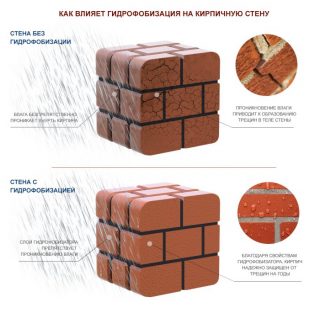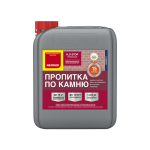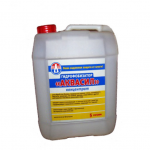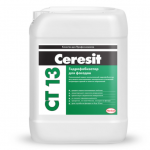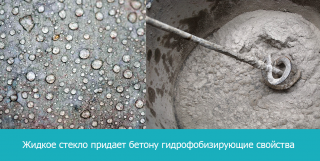It is possible to extend the operating time of a brick building by increasing the protection of the wall masonry from water and dampness. Capillary moisture particles contain harmful chemicals from the atmosphere that alter the internal structure of the material. To avoid the destruction of masonry, the appearance of moss on the surface, it is better to use a water repellent for bricks. The product is applied simply, while the composition can be prepared by hand.
The need for treatment with a water repellent
The action of the water repellent:
- reducing the risk of efflorescence on the facade;
- inadmissibility of the appearance and development of fungi, mold, moss;
- repulsion from the surface of dirt, dust;
- protection against wetting of the outer layer of the brick.
Protection against moisture occurs as a result of the interaction of chemical reagents with components in the composition of a ceramic stone. Calcites change the structure of the material the fact that they are deposited inside the pores, so the dimensions of the voids are reduced.
The preparations include alkali metal salts, polymer particles are used.
Solutions are not harmful to health, resist temperature extremes, all types of precipitation, and sunlight. The external substance penetrates into the pores, pushes out the previously trapped water. The waterproof rating remains enhanced upon examination, even when the outer film is removed.
Varieties of water repellents and treatment methods
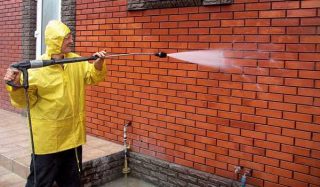
To protect brick walls, use about 100 types of various solutions... Choose a tool taking into account the processing method, state of aggregation, main components. They take into account the operating conditions, climate, scope of work.
The composition is applied or injected in several ways:
- applying the solution to the outer surface (roller, brush);
- volumetric hydrophobization in the brick production process;
- combined option (additional treatment to factory hydrophobization);
- shut-off waterproofing (drilling holes and injection of the compound).
Hydrophobic impregnation for bricks is available in the form of a paste, powder mixture, ready-made solution. The first two varieties need to be mixed with water before use. Liquids are usually ready to use, unless they are concentrates that are also diluted.
A drug are chosen taking into account the set goal:
- provide reliable protection against moisture;
- prevent the appearance of the facade from changing for the worse.
External treatments are often used, although the coating needs to be renewed from time to time. Regardless of the method of application, the funds are chosen according to the basis on which the drug is produced: water or silicone.
Effective water repellents according to builders
Silicone based preparations builders mark as effective means, but they not suitable if you need to finish the surface with tiles, artificial tiles, stone, plastering. Mortars will not adhere to the surface and water will run off.
Based on the recommendations of experts, compiled rating of brands of water repellents for brickwork:
- Aquasil. Produced on the basis of water or silicone, the film creates an effective waterproof effect. The drug is non-toxic, suitable for indoor and outdoor use in homes. Significantly extends the service life of the masonry.
- Silaxil. The popular aqueous solution is classified as environmentally friendly materials. Easily absorbed into the surface, hardens quickly. The result is a durable film with a long service life.
- Ceresit. The main advantage of the builders is the possibility of deep penetration, therefore, all the effects of hydrophobization are enhanced.
- Neomid. The product protects the masonry, fights the appearance of salt stains. The drug is used not only on newly folded surfaces, but also on old walls that are already starting to deteriorate.
The tool also works effectively Deyumikal... The composition contains many modifiers that increase performance. On old coatings, such a solution is applied two times. The product is flammable, therefore it requires caution when using.
Making a solution with a water-repellent impregnation with your own hands
When manufacturing on site, adhere to basic rules:
- the dosage is chosen carefully and strictly adhered to;
- mix all the components in good faith;
- reduce the water-cement ratio by 0.05%;
- the main components are loaded and mixed in the usual manner.

Brick processing technology with water repellents
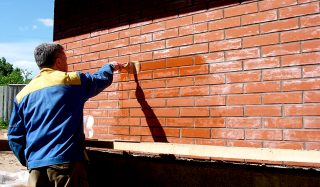
Water-repellent impregnation for bricks applied with a roller or brush... Before processing, the surface is cleaned of dirt, dust, and dried. On a wet surface, the product does not work as effectively. The cracks on the surface are cleared, and the solution is sealed.
Working rules:
- the agent is applied on a plane until it ceases to be absorbed into the material;
- the film appears quickly, but it will fully gain quality within a day, so the second layer is applied not earlier than this time.
After processing, the water-repellent properties of the surface are checked - if water is absorbed into the wall, the procedure must be repeated again. The product is applied evenly over the brick.
Finishing of the facade is carried out no earlier than 24 hours after treatment with a water repellent.


